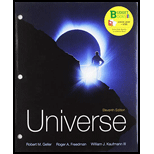
Concept explainers
(a)
The absolute magnitude of the star, HIP 72509, if the apparent magnitude of the star is
(a)
Answer to Problem 25Q
Solution:
Explanation of Solution
Given data:
The apparent magnitude of the star, HIP 72509, is
A parallax angle of the star, HIP 72509, is
Formula used:
The formula of the distance
The relation between the star’s apparent magnitude and absolute magnitude is written as:
Here,
Explanation:
The formula of the distance
The relation between the star’s apparent magnitude and absolute magnitude is written as:
Substitute
Substitute
Conclusion:
The absolute magnitude of the star, HIP 72509, is
(b)
The approximate ratio of luminosity of HIP 72509 to the Sun’s luminosity if the apparent magnitude of the star is
(b)
Answer to Problem 25Q
Solution:
Explanation of Solution
Given data:
The apparent magnitude of the star, HIP 72509, is
A parallax angle of the star, HIP 72509, is
Formula used:
The formula of the distance
Magnitude difference related to the brightness ratio:
Here,
The relation between luminosity of the stars from inverse-square law is:
Here,
Explanation:
The distance of star
Recall the expression that relates the magnitude difference to the brightness ratio for star HIP 72509 to the Sun.
The relation between luminosity of the star HIP 72509 and the Sun from inverse-square law is:
Rearrange for brightness ratio.
Combine the expression
Substitute
The distance of the Sun from Earth is
Substitute
Take anti log on both sides and solve as:
Conclusion:
The luminosity ratio of the star to the Sun is
Want to see more full solutions like this?
Chapter 17 Solutions
Universe - Text Only (Looseleaf)
- A G2 star has a luminosity 100 times that of the Sun. What kind of star is it? How does its radius compare with that of the Sun?arrow_forwardthe parallax angle of a star to be 0.002 arc-seconds. what would the distance be to this star?arrow_forwardThe luminosity of a star is 6.6 x 1031 W and the peak wavelength in its spectrum is 4.6 x 10-7 m. Calculate the surface area of that star. Round off the answer to 2 decimal places with scientific representation.arrow_forward
- The a star system contains two stars, one with apparent magnitude m = 10.5 and the other with m = 10.9. What is the combined apparent magnitude of the two stars?arrow_forwardIn a laboratory, the Balmer-beta spectral line of hydrogen has a wavelength of 486.1 nm. If the line appears in a star's spectrum at 486.7 nm, what is the star's radial velocity (in km/s)? (Enter the magnitude.) km/sarrow_forwardA star with a radius 1.5 times that of the Sun has a surface temperature T=9,000 K. Calculate the luminosity of this star and express your answer in units of the Solar luminosity (the Solar luminosity = 3.84 x 1026 W and the Solar radius = 7 x 108 m)arrow_forward
- A star has a peak output at 440 nm and has a luminosity of 3 solar luminosities. What is its radius? (LS=3.826 X 1026 J/s)arrow_forwardA star has a luminosity (power output) of 9.2x1026 W and a diameter of 6.1x108 m. What is its surface temperature? (Give your answer in SI units and include the units in your answer.)arrow_forwardYou receive 8 × 10−9 W/m2 of energy from a star that is 2 parsecs away, it has a V -band apparentmagnitude mV = −1.5. How much more/less flux do you receive from a star with an apparent magnitudemV = 5.3? For the first star, what is its V -band absolute magnitude?arrow_forward
- Show that if two stars of the same luminosity form a close binary pair, the magnitude apparent light of the pair measured together is about 0.75 magnitudes brighter than any of the individual stars.arrow_forwardThe apparent visual magnitude of star (Rigel) is 0.12. Use the method of spectroscopic parallax to calculate the approximate distance to Rigel in units of parsecs. The absolute visual magnitude of Rigel is −6.8.arrow_forwardThe star G1710 is currently at a distance of 62 lightyears and has an apparent visual magnitude of +9.7 . It is expected that, in a million years, GI710 will pass within one lightyear of the Earth. Calculate what the apparent visual magnitude of Gl10 will be at this time. Assume that the intrinsic brightness remains the same as it is today.arrow_forward
 Foundations of Astronomy (MindTap Course List)PhysicsISBN:9781337399920Author:Michael A. Seeds, Dana BackmanPublisher:Cengage Learning
Foundations of Astronomy (MindTap Course List)PhysicsISBN:9781337399920Author:Michael A. Seeds, Dana BackmanPublisher:Cengage Learning Stars and Galaxies (MindTap Course List)PhysicsISBN:9781337399944Author:Michael A. SeedsPublisher:Cengage Learning
Stars and Galaxies (MindTap Course List)PhysicsISBN:9781337399944Author:Michael A. SeedsPublisher:Cengage Learning AstronomyPhysicsISBN:9781938168284Author:Andrew Fraknoi; David Morrison; Sidney C. WolffPublisher:OpenStax
AstronomyPhysicsISBN:9781938168284Author:Andrew Fraknoi; David Morrison; Sidney C. WolffPublisher:OpenStax


